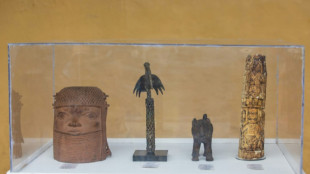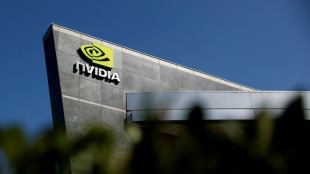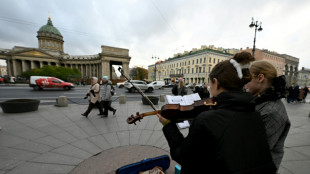
-
 Boston museum returns two Benin Bronzes to Nigeria
Boston museum returns two Benin Bronzes to Nigeria
-
Stock markets track Wall St down with Nvidia, US jobs in view

-
 Malaysia to appeal to CAS after damning FIFA report on forgery scandal
Malaysia to appeal to CAS after damning FIFA report on forgery scandal
-
TotalEnergies accused of Mozambique war crimes 'complicity'

-
 England quick Wood back bowling after injury scare
England quick Wood back bowling after injury scare
-
US lawmakers set for explosive vote on Epstein files

-
 Gianfranco Rosi: the slow documentary maker in a frantic world
Gianfranco Rosi: the slow documentary maker in a frantic world
-
P.Priime, Nigeria's young leading Afrobeats producer

-
 Merz, Macron to push for European digital 'sovereignty'
Merz, Macron to push for European digital 'sovereignty'
-
Trump hosts Saudi prince for first time since Khashoggi killing

-
 Tonga's Katoa out of NRL season after brain surgery
Tonga's Katoa out of NRL season after brain surgery
-
Japan warns citizens in China over safety amid Taiwan row

-
 In Somalia, a shaky front line barely holds back the 'dogs of war'
In Somalia, a shaky front line barely holds back the 'dogs of war'
-
Shares in 'Baby Shark' studio jump on market debut

-
 Thunder breeze past Pelicans, Pistons overpower Pacers
Thunder breeze past Pelicans, Pistons overpower Pacers
-
Grieving Cowboys remember Kneeland, defeat Raiders

-
 Loaf behind bars: Aussie inmate says Vegemite a human right
Loaf behind bars: Aussie inmate says Vegemite a human right
-
In film's second act, 'Wicked' goes beyond Broadway musical

-
 Asian markets track Wall St down with Nvidia, US jobs in view
Asian markets track Wall St down with Nvidia, US jobs in view
-
Scott Boland: the best 'spare' fast bowler around

-
 Fire and Ashes: England bank on fast bowling barrage in Australia
Fire and Ashes: England bank on fast bowling barrage in Australia
-
North Korea says Seoul-US sub deal will trigger 'nuclear domino' effect

-
 Education for girls hit hard by India's drying wells
Education for girls hit hard by India's drying wells
-
Haitian gangs getting rich off murky market for baby eels

-
 Trump says will talk to Venezuela's Maduro, 'OK' with US strikes on Mexico
Trump says will talk to Venezuela's Maduro, 'OK' with US strikes on Mexico
-
Oscar Piastri wins Australia's top sports honour

-
 'Severely restricted': Russia's Saint Petersburg faces cultural crackdown
'Severely restricted': Russia's Saint Petersburg faces cultural crackdown
-
Polish PM denounces 'sabotage' of railway supply line to Ukraine

-
 UK toughens asylum system with radical overhaul
UK toughens asylum system with radical overhaul
-
Carney's Liberals pass budget, avoiding snap Canada election

-
 LeBron back in training, edges closer to Lakers return
LeBron back in training, edges closer to Lakers return
-
Climate talks run into night as COP30 hosts seek breakthrough

-
 Germany and Netherlands lock up World Cup spots in style
Germany and Netherlands lock up World Cup spots in style
-
Germany's Woltemade hopes for 2026 World Cup spot after scoring again

-
 Germany 'send message' with Slovakia rout to reach 2026 World Cup
Germany 'send message' with Slovakia rout to reach 2026 World Cup
-
Trump unveils fast-track visas for World Cup ticket holders

-
 Netherlands qualify for World Cup, Poland in play-offs
Netherlands qualify for World Cup, Poland in play-offs
-
Germany crush Slovakia to qualify for 2026 World Cup

-
 Stocks gloomy on earnings and tech jitters, US rate worries
Stocks gloomy on earnings and tech jitters, US rate worries
-
'In it to win it': Australia doubles down on climate hosting bid

-
 Former NFL star Brown could face 30 yrs jail for shooting case: prosecutor
Former NFL star Brown could face 30 yrs jail for shooting case: prosecutor
-
Fate of Canada government hinges on tight budget vote

-
 New research measures how much plastic is lethal for marine life
New research measures how much plastic is lethal for marine life
-
Mbappe, PSG face off in multi-million lawsuit

-
 EU defends carbon tax as ministers take over COP30 negotiations
EU defends carbon tax as ministers take over COP30 negotiations
-
McCartney to release silent AI protest song

-
 Stocks tepid on uncertainty over earnings, tech rally, US rates
Stocks tepid on uncertainty over earnings, tech rally, US rates
-
Louvre shuts gallery over ceiling safety fears

-
 'Stranded, stressed' giraffes in Kenya relocated as habitats encroached
'Stranded, stressed' giraffes in Kenya relocated as habitats encroached
-
US Supreme Court to hear migrant asylum claim case


Billion-light-year-wide 'bubble of galaxies' discovered
Astronomers have discovered the first "bubble of galaxies," an almost unimaginably huge cosmic structure thought to be a fossilised remnant from just after the Big Bang sitting in our galactic backyard.
The bubble spans a billion light years, making it 10,000 times wider than the Milky Way galaxy.
Yet this giant bubble, which cannot be seen by the naked eye, is a relatively close 820 million light years away from our home galaxy, in what astronomers call the nearby universe.
The bubble can be thought of as "a spherical shell with a heart," Daniel Pomarede, an astrophysicist at France's Atomic Energy Commission, told AFP.
Inside that heart is the Bootes supercluster of galaxies, which is surrounded by a vast void sometimes called "the Great Nothing".
The shell contains several other galaxy superclusters already known to science, including the massive structure known as the Sloan Great Wall.
Pomarede said the discovery of the bubble, which is described in research he co-authored that was published in The Astrophysical Journal this week, was "part of a very long scientific process".
It confirms a phenomenon first described in 1970 by US cosmologist -- and future physics Nobel winner -- Jim Peebles.
He theorised that in the primordial universe -- then a stew of hot plasma -- the churning of gravity and radiation created sound waves called baryon acoustic oscillations (BAOs).
As the sound waves rippled through the plasma, they created bubbles.
Around 380,000 years after the Big Bang the process stopped as the universe cooled down, freezing the shape of the bubbles.
The bubbles then grew larger as the universe expanded, similar to other fossilised remnants from the time after the Big Bang.
Astronomers previously detected signals of BAOs in 2005 when looking at data from nearby galaxies.
But the newly discovered bubble is the first known single baryon acoustic oscillation, according to the researchers.
- 'Unexpected' -
The astronomers called their bubble Ho'oleilana -- "sent murmurs of awakening" -- taking the name from a Hawaiian creation chant.
The name came from the study's lead author Brent Tully, an astronomer at the University of Hawaii.
The bubble was discovered by chance, as part of Tully's work searching through new catalogues of galaxies.
"It was something unexpected," Pomarede said.
Tully said in a statement that the bubble is "so huge that it spills to the edges of the sector of the sky that we were analysing".
The pair enlisted the help of Australian cosmologist and BAO expert Cullan Howlett, who "mathematically determined the spherical structure which best corresponded to the data provided," Pomarede said.
This allowed the trio to visualise the three-dimensional shape of Ho'oleilana -- and the position of the archipelagos of galaxies inside it.
It may be the first, but more bubbles could soon be spotted across the universe.
Europe's Euclid space telescope, which launched into July, takes in a wide view of the universe, potentially enabling it to snare some more bubbles.
Massive radio telescopes called the Square Kilometre Array, being built in South Africa and Australia, could also offer a new image of galaxies from the viewpoint of the Southern Hemisphere, Pomarede said.
B.Khalifa--SF-PST




